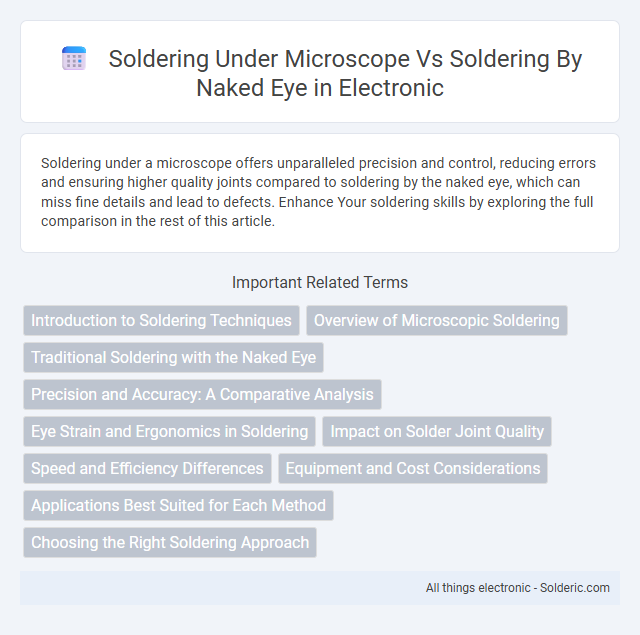Soldering under a microscope offers unparalleled precision and control, reducing errors and ensuring higher quality joints compared to soldering by the naked eye, which can miss fine details and lead to defects. Enhance Your soldering skills by exploring the full comparison in the rest of this article.
Comparison Table
| Criteria | Soldering Under Microscope | Soldering by Naked Eye |
|---|---|---|
| Precision | High accuracy for fine, detailed work | Limited precision, suitable for larger components |
| Visual Clarity | Magnified view enhances clarity | Standard vision, no magnification |
| Work Speed | Slower due to careful handling | Faster for simple tasks |
| Component Size | Ideal for small or micro components | Suitable for medium to large components |
| Error Rate | Lower error rate with better inspection | Higher risk of errors with small parts |
| Equipment Cost | Higher initial investment for microscope gear | Minimal cost, basic soldering tools |
| Ergonomics | Potential strain due to fixed posture | More natural hand and eye movement |
| Use Case | Microelectronics, PCB repair, precision work | General electronics, larger solder joints |
Introduction to Soldering Techniques
Soldering under a microscope enhances precision by magnifying small components, making it ideal for delicate electronics and intricate circuit boards where accuracy is critical. Soldering by the naked eye suits larger or less detailed tasks but may increase the risk of errors or cold joints due to limited visibility. Your choice of technique should align with the complexity and scale of the soldering project to ensure optimal reliability and performance.
Overview of Microscopic Soldering
Microscopic soldering utilizes high-magnification optics to enable precision placement and bonding of minute electronic components, significantly improving joint quality and reducing defects. The enhanced visibility helps in identifying solder bridges, cold joints, and insufficient solder, which are often missed when soldering by naked eye. This technique is essential in advanced electronics manufacturing, microelectronics repair, and intricate circuit board assembly where accuracy is critical.
Traditional Soldering with the Naked Eye
Traditional soldering with the naked eye relies heavily on manual dexterity and visual acuity, which can limit precision when working with tiny components or fine-pitch connections. Without magnification, You may struggle to detect solder bridges, cold joints, or insufficient solder, increasing the risk of defects and rework. While cost-effective and accessible, naked-eye soldering lacks the enhanced accuracy and quality control provided by microscopically assisted soldering techniques.
Precision and Accuracy: A Comparative Analysis
Soldering under a microscope significantly enhances precision and accuracy by providing magnified, detailed views of intricate components, enabling you to place solder exactly where needed and avoid bridging or cold joints. Compared to soldering by the naked eye, which relies on limited visual clarity and can lead to misalignment or soldering errors, microscope-assisted soldering improves repeatability and reduces defects in delicate electronics. This technique is especially critical for fine-pitch components and micro-soldering tasks that demand exact control and measurement.
Eye Strain and Ergonomics in Soldering
Soldering under a microscope significantly reduces eye strain by providing magnified, clearer views of intricate solder joints, allowing for more precise work without excessive squinting or leaning. Ergonomically, microscope soldering encourages better posture through adjustable stands, minimizing neck and back strain compared to the hunched positions often adopted when soldering by naked eye. This combination of improved visual clarity and ergonomic support enhances overall comfort and efficiency during extended soldering sessions.
Impact on Solder Joint Quality
Soldering under a microscope significantly enhances solder joint quality by providing magnified visibility, allowing for precise alignment and detection of defects such as cold joints, bridging, or insufficient solder. This improved accuracy reduces the risk of rework and increases the reliability of electronic assemblies, especially in high-density or fine-pitch components. In contrast, soldering by the naked eye often results in less detailed inspection, increasing the likelihood of hidden flaws that can compromise long-term performance.
Speed and Efficiency Differences
Soldering under a microscope significantly enhances precision, reducing errors and rework, which increases overall efficiency despite slightly slower initial speeds. Naked eye soldering allows faster completion of simple tasks but tends to produce more defects, leading to longer cumulative project times due to corrections. Optimizing speed and efficiency depends on component complexity, with microscopic soldering favored for intricate, fine-pitch assemblies requiring high accuracy.
Equipment and Cost Considerations
Soldering under a microscope requires specialized equipment such as a binocular microscope with adjustable magnification, precision soldering irons, and stable stands, which significantly increase initial setup costs compared to naked-eye soldering. The investment in high-quality optics and ergonomic tools enhances accuracy and reduces errors, essential for working with miniature components like microchips and fine-pitch PCBs. Your overall expenses will rise due to the need for maintenance and potential upgrades to optical systems, but these costs are justified by improved precision and reduced rework rates in electronics assembly.
Applications Best Suited for Each Method
Soldering under a microscope is best suited for intricate electronics work such as surface-mount device (SMD) assembly, micro soldering on printed circuit boards (PCBs), and repairs requiring high precision, like smartphone or medical device components. Soldering by the naked eye is more appropriate for larger, less complex tasks including basic wiring, cable splicing, or through-hole component soldering where fine detail is less critical. Your choice between these methods depends on the scale and precision needed for the specific application to ensure optimal results.
Choosing the Right Soldering Approach
Choosing the right soldering approach depends on the precision required and the component size; soldering under a microscope offers enhanced visibility and accuracy for intricate tasks such as microelectronics and fine-pitch components, reducing the risk of bridging or cold joints. In contrast, soldering by the naked eye is suitable for larger components and less delicate assemblies where rapid work is prioritized over extreme precision. Assessing factors like component density, solder joint size, and inspection requirements ensures optimal method selection for quality and efficiency.
soldering under microscope vs soldering by naked eye Infographic

 solderic.com
solderic.com